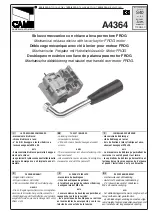
6
Fig 4
Mount the working table (H).
Screw the lock handle (G, Fig 2) into
the table support.
With the aid of a second person,
carefully lift the head onto the column
top.
Caution: The head assembly is
heavy! Use care when lifting onto
the column!
Rotate the head assembly until the
sides of the belt cover are parallel with
the sides of the base.
Tighten the set screws (M, Fig. 5).
Fig 5
Install three down feed handles (C, Fig
2) into the down feed hub.
Install the chuck guard (I, Fig 2).
Initial lubrication:
Lubricate gently with grease.
-the drive splines (grooves) in the
spindle
-the teeth of the quill
-the column-rack
5.3 Mains connection
Mains connection and any extension
cords used must comply with
applicable regulations.
The mains voltage must comply with
the information on the machine
licence plate.
The mains connection must have a
10 A surge-proof fuse.
Only use power cords marked
H07RN-F
Connections and repairs to the
electrical equipment may only be
carried out by qualified electricians.
5.4 Starting operation
You can start the machine with the
green on button. The red button on the
main switch stops the machine.
Version 400V:
If the direction of rotation is not
correct, the phase converter inside the
CCE Euro plug must be pushed in and
turned 180°.
Break in of V-belt:
Before further using the drill press, it
is advisable to break in the V-belt.
Tighten the belt and keep the machine
running at 1200 rpm for approximately
30 minutes.
6. Machine operation
Always adjust the table and the depth
stop to prevent drilling into the table.
Use a back-up piece of scrap wood to
cover the table. This protects both the
table and the drill bit.
Secure workpiece to the table with
clamps or a vice to prevent rotating
with the drill bit.
T-slot size is 12mm.
Feed the bit into the material with only
enough force to allow the drill bit to
work.
Feeding too slowly may cause burning
of the workpiece.
Feeding too quickly may cause the
motor to stop and/or the drill bit to
break.
Recommended speeds for a 10mm
HSS drill:
Wood:
2000 RPM
Plastic:
1500 RPM
Aluminium:
1500 RPM
Brass:
1500 RPM
Cast iron:
1000 RPM
Mild steel:
800 RPM
High carbon steel:
600 RPM
Stainless steel:
300 RPM
Generally speaking, the smaller in
relation the drill bit, the greater the
RPM required.
Wood requires higher speeds than
metal.
Metal is usually drilled at slower
speeds; cutting oil is applied if
necessary.
Warning:
Always keep your hands well clear of
the rotating bit.
Do not remove chips and workpiece
parts until the machine is at a
standstill.
Always close the chuck guard and
pulley cover before you start the
machine.
When using a drill press vice, always
fasten it to the table.
Never do any works “freehand” (hand-
holding the work piece rather than
supporting it on the table), except
when polishing.
Support long workpieces with helping
roller stands.
Do not use wire wheels, router bits,
shaper cutters, circle cutters, or rotary
planers on this drill press.
Never cut magnesium-
high danger of fire!
7. Setup and adjustments
General note:
Setup and adjustment work may
only be carried out after the
machine is protected against
accidental starting by pulling the
mains plug.
7.1 Removing the Chuck and
Arbour
Unplug the machine from the power
source.
Lower the quill using the down feed
handle.
Rotate the spindle to align the key in
the spindle with the key hole in the
quill.




































